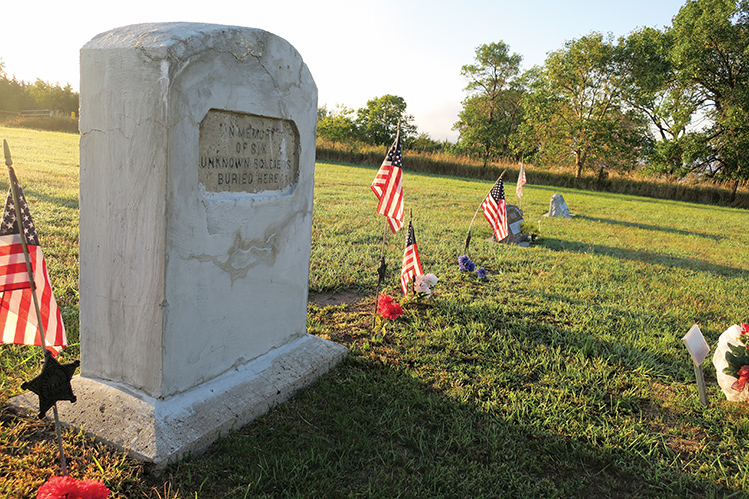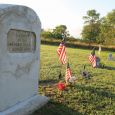The Gift of South Dakota
Subscriptions to South Dakota Magazine make great gifts!
Subscribe today — 1 year (6 issues) is just $29!
The Mysterious Custer Graves
Aug 26, 2020
 |
| A stone in the Bon Homme Cemetery marks the graves of six unknown men believed to be members of the Seventh Cavalry. Legend says they died while marching through Dakota Territory in 1873. |
There’s a mystery along the Apple Tree Road in Bon Homme County that has stumped local historians for decades: the identities of six soldiers buried in the Bon Homme Cemetery, said to be members of Lt. Col. George Armstrong Custer’s Seventh Cavalry who died while passing through Dakota Territory in 1873.
Custer and his men arrived on the outskirts of Yankton in early April and set up camp west of town near the present-day stockyards. They were embarking on a 400-mile march from Sioux City to Fort Rice in northern Dakota Territory. Fort Rice was to be the launching point for a summer expedition along the Yellowstone River.
The Seventh intended to stay no more than a few days, but even in 1873 the locals knew not to trust the weather in early spring. A severe blizzard that came to be known as the Custer Blizzard blew through town and delayed their departure until early May.
The unexpected layover in Yankton allowed the men to explore the young town and gave us stories that are still told today. One regards the local bandleader who assembled a group of musicians to play at a ball that town leaders hosted for the Seventh. Custer was so impressed with his musical abilities that he invited him to join the cavalry as its chief musician on the journey to Fort Rice. Felix Vinatieri accepted, and led a 16-member band as the cavalry paraded out of town on May 7. Fortunately, the band was left behind as Custer and his men trudged off to the ill-fated Battle of the Little Bighorn in 1876. If they’d gone along, the world may never have known Adam Vinatieri, Felix’s great-great-grandson and one of the greatest kickers the National Football League has ever seen.
Custer and his men didn’t march very far before they were delayed once again. Rapid snowmelt flooded both Emanuel and Chouteau creeks in western Bon Homme County. They encamped along Snatch Creek while a detachment went ahead to bridge the waterways.
The Seventh stayed four days, during which time Custer and several officers took meals at the nearby Cogan House, a hotel in the village of Bon Homme run by Bridget Cole Cogan, an Irish immigrant. It was during this short encampment that legend says six soldiers became ill, perhaps from typhoid fever, and died. Graves were quickly and quietly dug along the western bank of Snatch Creek. The men were buried there until 1893, when they were moved to the Bon Homme Cemetery. In 1922, a local stonemason crafted the large tombstone that marks the graves today.
Local historians have tried for decades with no luck to determine the names of the long-lost men. Regimental records indicate no deaths during May of 1873, and no mention is made of such an occurrence in the many memoirs written by participants in the journey or in contemporary newspaper accounts penned by journalists accompanying the Seventh.
We traveled to the old Bon Homme village site and met Greg McCann, who knows the legends better than most. He is Bridget Cole Cogan’s great-nephew and operates his modern-day Cogan House — a bed and breakfast along the banks of the Missouri River — not far from where the original once stood. He showed us depressions in the ground believed to mark the spot where Custer himself camped, chosen because of its ideal view of the river, the nearby military trail and Bon Homme.
McCann says he believes the widely held theory that the deaths were kept quiet because if word that such a contagious disease was spreading among the Seventh, the cooperation Custer so heavily needed from communities and Indian tribes along the route to Fort Rice would be jeopardized.
We published a story on the Custer graves in the fall of 2016 and made it available on our website several months later. Recently, a reader commented that an ancestor of hers fought with Custer, supposedly at the Little Bighorn, but never returned. She wondered if perhaps he died much earlier and lies in one of the graves.
For decades, paper trails have gone cold. Someday one is bound to warm up.










Comments
The day before Custers men arrived at the Bon Homme camp, they had partied late in an old wooden dance hall in Yankton that was accross and to the east of the Chad Gurney Hotel. Most of these men walked the 30 miles to BonHomme. They were delayed there by 3 weeks and several women baked bread and soup for them, my great grandmother (Martha Abbott)was one of these women.
My husbands great great grandparents were at Chouteau Creek from 1872-1879.
Justus Pooler Sherman served as the postmaster there, handling the mails from Tackett Station. I m searching for stories to learn about their lives. Mele Lacharite Sherman his Métis wife bore three children during this time.2 in Wagner and one in Springfield. This son was Joesph Cruso Sherman who married Imogene Dewey. They lived around Monowi,Niobrara and Verdel.
Thank you for the added layers of this marvelous area called Bon Homme.